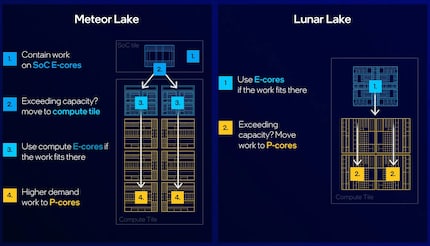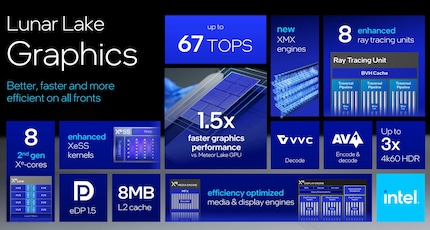
Background information
Qualcomm Snapdragon X Plus and Elite – revolution for the laptop world?
by Martin Jud

Intel unveiled "Lunar Lake" at Computex. With the new notebook chip architecture, which also delivers strong AI performance, the company wants to keep up with Qualcomm's Snapdragon chips from the autumn.
Intel surprises with new mobile system-on-a-chip (SoC), which is set to appear in the first notebooks from autumn. With the Lunar Lake architecture comes a chip design that is supposed to offer a 60 per cent longer battery life and even has integrated RAM, among other things. The low-power efficiency cores introduced last year with Meteor Lake (Core Ultra) are already history.
The timing of the new Intel chips is not a common one in the company's history. Usually, the company has optimised a new chip design after its introduction - sometimes several times - until a new one comes along. Intel is in a tight spot due to competition from Qualcomm and AMD and is therefore launching a completely new chip design on the market ahead of schedule.
As soon as you look at the new chip, it becomes clear what the most important new feature of Lunar Lake is. Two memory blocks can be seen below the large silicon surface. Depending on the processor model, these are 16 or 32 gigabytes of LPDDR5X memory.

According to Intel, the integrated RAM is said to consume up to 40 per cent less power when copying. The disadvantage compared to mainboard-mounted RAM is that it cannot be expanded.
Last year, Intel focussed on performance, efficiency and low-power efficiency cores for Meteor Lake. The company has now moved away from this "3D performance hybrid architecture". This was because the separate core zones warmed each other up too much (e.g. when using Microsoft Teams).

Now a 4×4 system is supposed to do this better. The Lunar Lake chips utilise up to four new "Lion Cove" performance cores plus four new "Skymont" efficiency cores. These are not hyperthreading-capable. According to Intel, hyperthreading no longer makes sense with the new core size - SMT technology consumes more power and space than it is worth.
Compared to the previous generation, the new performance cores are said to offer up to 14 per cent more performance at the same clock rate. The single-core performance is said to be increased by up to 20 per cent. And the efficiency cores are said to offer better performance than the performance cores of the previous generation despite lower power consumption at typical laptop clock rates.
Microsoft Teams is said to consume up to 35 per cent less power thanks to the new design under Lunar Lake.
The new Neural Processing Unit (NPU) offers more than three times the AI performance. It clocks at 1.95 gigahertz and is expected to achieve 48 trillion operations per second (TOPS). This would make it the second-fastest NPU to date - AMD aims to deliver 50 TOPS with its Ryzen AI 300 processors. Intel therefore easily fulfils Microsoft's requirement for AI PCs of 40 TOPS.

The Xe2 GPU integrated on the Lunar Lake chip is said to deliver 1.5 times the performance of Meteor Lake in 3DMark Time Spy. Meteor Lake has already doubled the performance of the previous generation, so the increase in performance compared to the previous year is considerable.
Whether Intel can hold its own against Qualcomm and AMD in the notebook segment with Lunar Lake and the promised 60 per cent longer battery life will be clarified from autumn. In addition to the CPU, NPU and GPU, there are countless other features on the new SoC. These include support for Wi-Fi 7, Bluetooth 5.4 and native H.265 conversion. Intel also guarantees at least two Thunderbolt 4 ports on Lunar Lake laptops.
I find my muse in everything. When I don’t, I draw inspiration from daydreaming. After all, if you dream, you don’t sleep through life.
From the latest iPhone to the return of 80s fashion. The editorial team will help you make sense of it all.
Show all